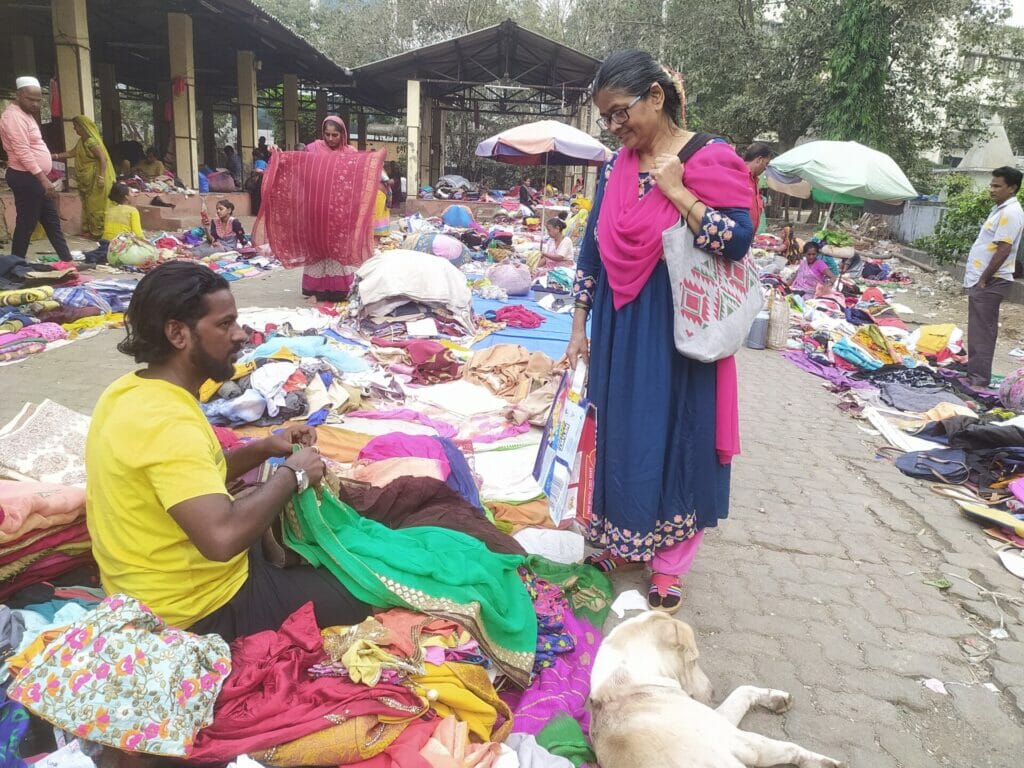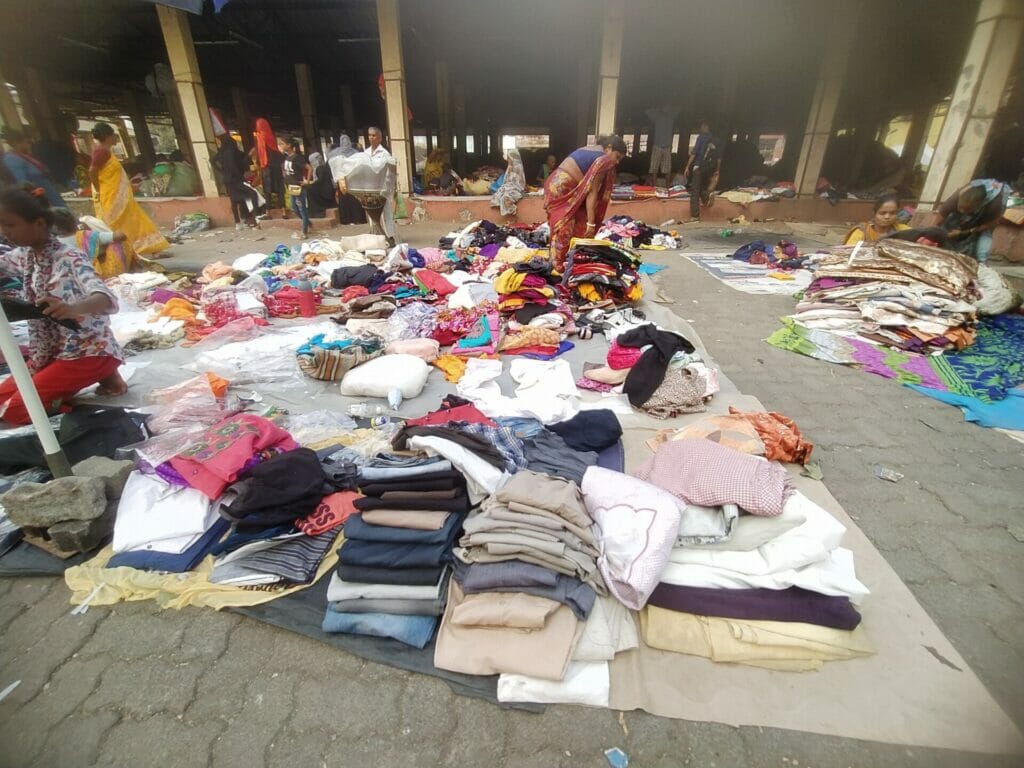The weekly used clothes market at Marol is perhaps one of Mumbai’s best hidden treasures. Tucked inside Andheri’s Marol dry fish market, old, used clothes arrive here from across the city, especially western suburbs. These are brought by vendors who go door-to-door collecting clothes and exchanging them for vessels. They are traditional recyclers – people carrying baskets of vessels on their heads and a bagful of clothes dangling down their shoulders.
What’s on sale
The mainstay of the market is used clothes, but now it has expanded to a wide range of paraphernalia including used shoes, bags and suitcases, electronic gadgets and even used mobiles.
The clothes are brought in through these unique exchange models and other items are brought by the scrap dealers. Clothes donated to charity organisations also make their way here, according to vendors. At times, brand new clothes also arrive – either rejected pieces from garment manufacturers or excess, unsold clothes disposed of by outlets.

Read more: What are the demands of Mumbai’s street vendors?
How does the recycling clothes business model work?
This system serves marginalised customers who are at the heart of Mumbai’s informal recycling business. This informal, traditional mode of recycling trade is hardly lucrative for the vendors. “Since the entire business model works only for the extremely poor, the margins are really low but just good enough to run our homes. At times, we struggle to sustain for the week,” says Arvind Suresh Waghri, 35, whose family has been in this trade for generations.
“At times our clothes are of much better quality than the brand new clothes sold on streets. These are good brands which are discarded either because new trends have emerged in the market or because the affluent lose interest in clothes after wearing them a few times,” says an old vendor who didn’t want to be identified.
No one is quite sure when and how this system of recycling clothes started. Most of the vendors hail from the traditional Waghri community, who have been described as urban India’s invisible recyclers’ for their role in traditional recycling of clothes, and have been doing this for generations.
This model is different from the commercial second-hand clothes trade that operates internationally. Globally, the used clothes market is estimated to be worth 40 billion dollars annually. India is the world’s top importer of used clothes. The Wall Street Journal reported that Gujarat’s Kandla port is the hub of a second-hand clothes market that receives castoff clothes from Western countries that are then processed in shoddy industries in Panipat.
A France24 investigation revealed that the worldwide secondhand clothing economy was worth around five billion euros and about eight million tonnes of used clothes garments were collected by the West and sent to third world nations.
The method of recycling clothes for markets
The used clothes received through the week are sorted out in various categories depending on their quality. The good quality ones that can be worn again get sold in the retail market like Marol, where they fetch a better price. The not-so-good quality or even torn clothes get sold at wholesale rates in places like Chor Bazaar, where they are picked up for industrial use. Such clothes in bulk are repurposed into yarns to be used for making blankets, rugs, pillow stuffings and insulation materials.
Apart from the Marol market, similar recycled clothes markets are also found at the original Chor Bazaar near Pydhonie and at Mulund. These markets represent Mumbai’s buzzing informal economy.
Who are the customers at this market?
People visiting this market seemed embarrassed about the economic conditions that force them into using hand-me-downs. The first thing that most customers emphasised was that they either rarely or never come here.
A mother with two pre-teen daughters was here to shop for woollen wear. Her husband works in ‘service’ – a term loosely used for odd jobs in offices or small units. She bought a sweater for one daughter for Rs 70, but one of the daughters refused to buy a dress after she noticed a stain on it. She had bargained to bring the price to Rs 50 from Rs 100.
Another woman, who didn’t want to be identified, stated that she was there to buy a fancy dress costume for her child’s school function. She came here because she felt that she didn’t want to spend on a new dress to be worn just for one day.
Geeta Taldeokar is an exception. She recalls how this market was the only place where she could afford to buy sarees and dresses for her entire family of a husband and six children. She would provide tiffins at offices to support her family and couldn’t afford any sarees. “Here I could buy old sarees for Rs 100 when a new one would easily cost in thousands in shops that were beyond me,” she says. Today, her kids have grown up and are married, but times continue to be tough as the office where she provided tiffin service has shut and she is looking for new work opportunities.

Vendors have witnessed a change in the nature of the trade. Now they are exchanging clothes for mobiles, plastic chairs and even money, apart from vessels. Savita Kharwa, 70 recalls how she would trudge from buildings in the suburb of Vile Parle to sustain her family after her husband left her. Today, her sons are married and settled in other jobs. She is unable to carry the load of vessels and so now she just buys old clothes in lieu for money and sells the clothes at the Marol market. Getting into buildings these days has also got difficult with increased security restrictions that do not allow outsiders.
Future of such informal markets
Most of the traders in Marol market have been here for decades. However, they continue to be unrecognised as they are not considered licensed hawkers and continue to operate from the fringes of the Marol dry fish market. They also face resistance from the local dry fish vendors here.
“Though we have been coming here for trading since a long time and even pay the BMC fee, there is no guarantee that we would be allowed to continue here. Our entire business seems on the move with no security,” says a vendor, who didn’t want to be identified.
Read more: A ‘hafta’ system haunts hawkers in Mumbai

In his working paper on Urban Planning and informal livelihoods in India, an analysis of urban planning laws and processes, Mathew Idiculla argues that views of the informal sector should be factored into urban planning. He says urban plans are key legal and policy instruments, and they regulate whether and how informal workers can access public space, conduct their work, and pursue their livelihoods.
The poor who flock to the Marol used clothes market, would wholeheartedly agree to that.